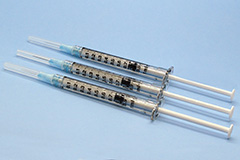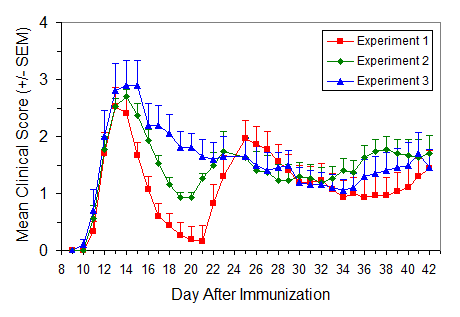
Hooke Kits™ for EAE Induction in SJL Mice
By active immunization with PLP139-151
Emulsion supplied in pre-filled syringes, ready to use.
- Consistently induces EAE in female SJL mice
EAE will develop in 90 to 100% of mice within 9 to 15 days from immunization. Approximately 50 to 80% of mice will relapse after initial partial or complete recovery. Maximum score for individual mice will typically be 2.0 to 3.5.
Each lot is tested and individually adjusted to ensure consistent disease induction.
- Eliminates tedious preparation of emulsions
Properly prepared emulsions are critical for reliable induction of many autoimmune disease models. Our emulsions are carefully made and pre-filled into syringes, ready to use, to reduce time needed to set up experiments.
- Saves time and mice in testing individual reagents
Lot-to-lot reagent variations can cause dramatic changes in severity of induced autoimmune disease. The consistent potency of pre-characterized Hooke Kits™ eliminates time-consuming testing.
- Reduces your mouse facility's exposure to pathogen contamination
Pre-filled syringes are prepared under aseptic conditions and delivered in sterilized plastic bags for easy disinfection before introduction into your mouse facility.
Experimental autoimmune encephalomyelitis (EAE) is the model most commonly used to study efficacy of potential drugs for treatment of multiple sclerosis (MS).
Because of its many similarities to MS, EAE is used to study pathogenesis of autoimmunity, CNS inflammation, demyelination, cell trafficking and tolerance induction.
EAE is characterized by paralysis (in some models the paralysis is relapsing-remitting), CNS inflammation and demyelination. EAE is initiated by myelin-specific CD4+ T cells, with glia cells (microglia and astrocytes), B cells, macrophages, NK cells, and dendritic cells all playing important roles in disease development.
Kit selection
For most labs we recommended starting with kit EK-0120 for study of either the initial wave of EAE, or for study of EAE relapses.
However, PLP139-151 induced EAE in SJL mice is sensitive to small variations in mice and in laboratory environments.
If EAE severity with EK-0120 is insufficient, and the goal is to study the initial wave of EAE, we recommend kit EK-2120, which includes pertussis toxin (PTX). The PTX induces a more severe initial wave of EAE, but it can also reduce the incidence and severity of relapses.
If EAE severity with EK-0120 is insufficient, and the goal is to study EAE relapses, we recommend EK-0230, which uses the native mouse PLP peptide. This will induce more severe EAE than EK-0120, and will not reduce relapse incidence.
For more information on model and antigen selection, please see Learning Center - What are the advantages and disadvantages of the different EAE models and antigens?.
| Cat # | Hooke Kit™ | Strain | Age | Description | Size | Price (first kit) |
Price (each add'l kit) |
|---|---|---|---|---|---|---|---|
| EK-0120 | [Ser140]-PLP139-151/CFA Emulsion1 | SJL | 8 to 9 weeks | Emulsion in syringes | 10 mice | $ 328 | $ 279 |
| EK-2120 | [Ser140]-PLP139-151/CFA Emulsion PTX | SJL | 8 to 9 weeks | Emulsion in syringes, PTX | 10 mice | $ 399 | $ 339 |
| EK-0230 | PLP139-151 (native)/CFA Emulsion | SJL | 8 to 9 weeks | Emulsion in syringes | 10 mice | $ 328 | $ 279 |
1 EK-0120 was called "PLP139-151/CFA Emulsion" prior to May 2020. Only the name has changed, to avoid confusion with EK-0230.
These kits can be customized for a small additional charge. Contact us at or with your requirements.
Protocols
Adoptive Transfer EAE in SJL Mice
EAE Induction by Active Immunization in SJL Mice
Immunization of Mice for Generation of Encephalitogenic T Cells
Detailed contents
Each kit provides sufficient reagents for 10 mice.
Antigen for EK-0120 and EK-2120 is serine-substituted [Ser140]-PLP139-151, sequence HSLGKWLGHPDKF.
Antigen for EK-0230 is native mouse PLP139-151, sequence HCLGKWLGHPDKF.
| Qty | Description |
|---|---|
| 3 | Syringes, pre-filled with 0.7 mL antigen/CFA emulsion
0.25 to 0.50 mg antigen/mL emulsion (adjusted per lot for consistent potency) ~ 1 mg killed mycobacterium tuberculosis H37Ra/mL emulsion (all concentrations adjusted by lot for consistent EAE induction) |
| 1 | Vial containing 1.5 µg pertussis toxin (PTX) in glycerol buffer (EK-2120 only) |
| 1 | Data sheet: Recommended experimental protocol, typical results |
Typical results

EAE induction in SJL mice
Protocol: EAE Induction by Active Immunization in SJL Mice
Data are from three independent experiments. Immunization used Hooke Kit™ [Ser140]-PLP139-151/CFA Emulsion (EK-0120), with female SJL mice.
| Exp. | # mice | Mean day of onset ± SD | MMS of 1st wave ± SD |
% EAE relapse | MMS of relapse1 ± SD |
MMS of relapse period (Days 21-42)2 ± SD |
End score (Day 42) ± SD |
Disease incidence |
|---|---|---|---|---|---|---|---|---|
| 1 | 15 | 13.3 ± 5.6 | 3.2 ± 0.5 | 87.0 % | 2.8 ± 0.6 | 2.7 ± 0.9 | 1.7 ± 1.2 | 100 % |
| 2 | 15 | 11.9 ± 0.6 | 2.7 ± 0.3 | 80.0 % | 2.9 ± 0.6 | 2.3 ± 1.3 | 1.4 ± 1.3 | 100 % |
| 3 | 10 | 12.3 ± 1.7 | 3.3 ± 0.9 | 80.0 % | 2.7 ± 0.7 | 2.7 ± 0.9 | 1.5 ± 1.0 | 100 % |
1 Only for mice which relapsed
2 For all mice in the group
Storage & stability
Stable for 20 days when stored at 2–4 °C.
Do not freeze.
References
Tuohy VK et al, J Immunol 142:1523 (1989)
McRae BL et al, J Neuroimmunol 38:229 (1992)
Product citations
Search Google Scholar for product citations (opens in new tab)
Safety Data Sheets (SDS)
PLP139-151/CFA Emulsion (PDF)
Pertussis toxin in glycerol (PDF) (EK-2120 only)
Related products
DS-0121 [Ser140]-PLP139-151 in TC media
DS-0161 PLP139-151 (native) in TC media
CK-0120
Hooke Control Kit™ for EK-0120 (full size)
CK-5120
Hooke Control Kit™ for EK-0120 (half size)
CK-2120
Hooke Control Kit™ for EK-2120 (full size)
CK-7120
Hooke Control Kit™ for EK-2120 (half size)
CK-0230
Hooke Control Kit™ for EK-0230 (full size)
CK-5230
Hooke Control Kit™ for EK-5230 (half size)


_150px.jpg)